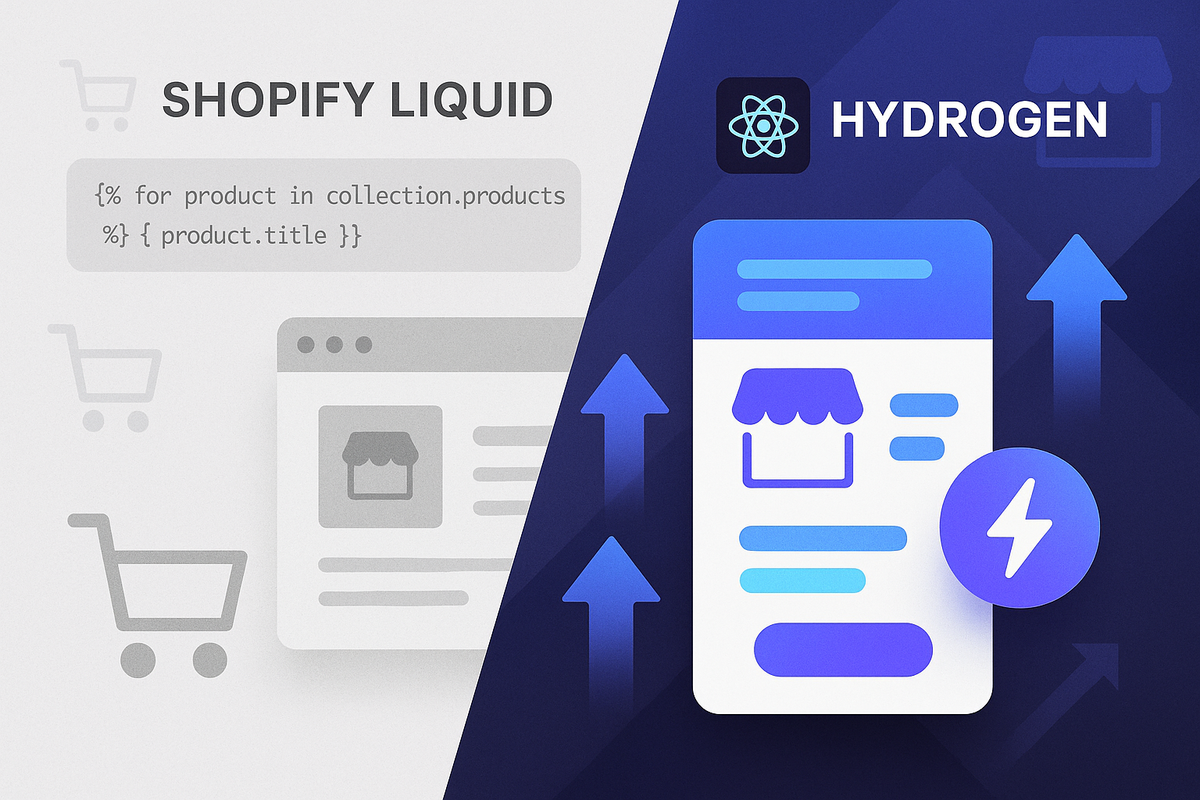As eCommerce matures, the limitations of traditional templating systems like Shopify's Liquid can become apparent, especially for brands seeking lightning-fast performance and boundless customization. Enter Shopify Hydrogen—a headless framework built on React that empowers merchants to create dynamic, high-speed storefronts decoupled from the backend. If you're experiencing bottlenecks in load times, design flexibility, or scalability on Liquid, transitioning to Hydrogen could redefine your store's potential, blending speed with innovative features for a more engaging user journey. From our insights at Arctic Grey, where we've navigated these migrations for diverse brands, this guide outlines the migration process, its benefits, and strategic considerations. Whether you're optimizing for global audiences or experimenting with new UX trends, these details can help you envision how Hydrogen might align with your growth ambitions.
Understanding Migration from Liquid to Shopify Hydrogen
Migrating from Liquid to Shopify Hydrogen involves shifting your storefront from Shopify's traditional theme-based system to a headless architecture. Hydrogen leverages React Server Components for server-side rendering, reducing client-side JavaScript and enabling features like edge caching and real-time data fetching via Shopify's Storefront API. This isn't a simple swap—it's a rearchitecture that preserves your data (products, orders, customers) while allowing for custom integrations with headless CMS or third-party services. For merchants, this means breaking free from Liquid's template constraints, gaining pixel-perfect control over designs, and deploying on platforms like Oxygen for global CDN support. The migration suits B2C, B2B, or multi-channel setups, ensuring compliance with SEO best practices and data security standards like GDPR, all while minimizing downtime through phased rollouts.
The Advantages of Migrating to Shopify Hydrogen
Benchmarks from Forrester and Aberdeen Group illustrate how Hydrogen's approach yields superior results over Liquid, often translating to direct business uplift. Here's a comparative overview, rooted in industry data:
|
Benefit
|
Hydrogen Edge Over Liquid
|
Potential Impact
|
|---|---|---|
|
Superior Performance
|
Server-side rendering cuts JS bundles by 30-50%
|
Up to 7% conversion boost per second of load time saved, with 1.4x faster navigation
|
|
Design Flexibility
|
Headless decoupling for custom UX trends like 3D previews or micro-animations
|
Enables immersive experiences, potentially lifting engagement by 20-30%
|
|
Scalability & Global Reach
|
Edge rendering and CDN integration for traffic spikes
|
Handles enterprise volumes with 99.99% uptime, reducing latency for international users
|
|
SEO Optimization
|
Fine-tuned control over meta tags, sitemaps, and structured data
|
32% potential increase in organic traffic through better rankings and crawl efficiency
|
|
Innovation & Sales Growth
|
Dynamic A/B testing and personalized recommendations
|
15-20% sales increases via agile experimentation and tailored content delivery
|
These advantages emerge from Hydrogen's modern stack, making it ideal for brands prioritizing speed, customization, and future-proofing in a mobile-first world.
Step-by-Step: How a Seamless Migration Unfolds
A structured migration ensures smooth transitions without disrupting sales. Based on effective methodologies, the process generally includes:
- Strategy & Assessment: Conduct audits of your Liquid setup, mapping goals like UX enhancements or integrations to build a custom roadmap.
- Design & Redesign: Incorporate 2025 trends such as minimalism, mobile-first navigation, and interactive elements to refresh your brand's visual identity.
- Development & Integration: Build modular components with React, syncing Shopify data and adding custom features like advanced filtering or loyalty programs.
- Optimization & Testing: Implement caching, code splitting, and performance tweaks, followed by QA for speed, compatibility, and security.
- Launch & Monitoring: Soft-launch with SEO safeguards, then track metrics like load times and conversions for iterative refinements.
This phased method, often completing in months, positions your store for immediate gains while allowing room for ongoing evolution.
Real-World Insights from Successful Migrations
The transformative power of Hydrogen migrations is evident in brand stories. One eCommerce director noted a 34% sales surge within six months, attributing it to refined UX that aligned perfectly with their vision. Another shared a 22% revenue lift in just 30 days, thanks to a collaborative process that "constantly refined every detail" for an engaging shopper experience. From fashion retailers achieving 30% conversion improvements to enterprises gaining 48% site speed boosts, these cases highlight recurring themes: error-free transitions, enhanced scalability, and partnerships that extend into long-term optimizations. Such narratives, spanning boutiques to global names, show how Hydrogen not only resolves legacy limitations but also sparks innovation, fostering deeper customer loyalty and operational agility.
Why Expertise Matters in Your Migration Journey
Tackling a Liquid-to-Hydrogen migration demands deep knowledge of React ecosystems, Shopify APIs, and eCommerce trends—elements that can turn a technical shift into a strategic leap. Seek partners with certified developers, a history of award-winning designs, and proven outcomes across 1,000+ stores, ensuring secure, efficient builds with full IP ownership. At Arctic Grey, our multi-award-winning framework—recognized for top agency excellence and generating substantial client revenue—prioritizes transparent milestones, white-glove support, and tailored integrations. It's this blend of expertise and dedication that makes the journey not just feasible, but profoundly rewarding, built on a foundation of trust and exceptional results.
Looking Ahead: The Role of AI in Hydrogen-Powered Stores
AI is amplifying Hydrogen's capabilities with tools for predictive personalization and automated A/B testing, enabling stores to adapt in real-time to user behaviors. Embracing these during migration can align your setup with emerging trends like hyper-targeted experiences, keeping your eCommerce edge sharp.
If these insights illuminate possibilities for your store, considering a customized migration plan might be a fitting next move. For more on migrating from Liquid to Shopify Hydrogen, explore our resource page. And if a discussion about your specific needs appeals, the Arctic Grey team is ready to connect—let's map out what's ahead.
About Arctic Grey: Specialists in Shopify builds, customizations, UX audits, migrations, ERP integrations, custom app development, mobile conversions, and Hydrogen migrations from Liquid.




